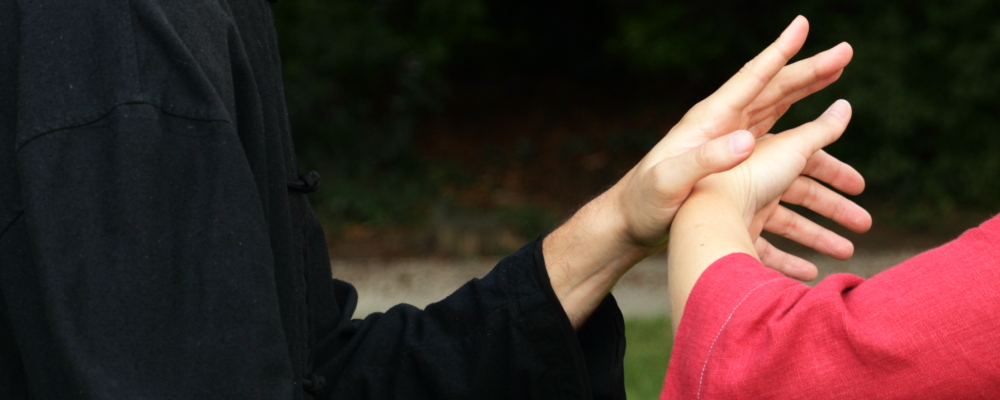
This is a common question, especially when starting taichi push hands and more so after having experienced different approaches. We are referring here to the pressure applied on the point of contact, without actually pushing or applying techniques.
Some schools tend to advocate a very light and soft pressure on the point of contact. The reasoning behind is usually that we don't want to give information to the opponent about our intentions. The main idea is that by applying pressure we are giving the opponent something that can be used against us.
In my push hands exchanges in Europe and USA, I have never found practitioners who could apply light pressure skillfully, that is without resorting to jerky reactions and overt aggression. They could be nice and light in their touch at first, but as soon as the situation got more demanding, they would react hard and with great haste, not based on structure or technique. Of course, most of these practitioners did not see the situation under the same light and thought they were applying real skill.
In reality, while it is possible that even a small pressure on the point of contact be used against us, this requires a significant level of skill so it should not bother us much at first, while we are learning the foundations of push hands.
Other schools apply a lot of pressure on the point of contact. The tenet here is that training in this manner allows us to distinguish clearly the bodily structure and the forces we apply, so that we can develop the right alignment while being relaxed. This style emphasizes clear structure and heavy relaxation.
These practitioners are usually more solid in their practice but they tend to bump into obstacles for their development, because the subtle aspects of neutralization are hard to figure out in this manner.
In contrast, an approach where we apply natural pressure on the point of contact is one that does not add nor takes away from the point of contact. We just present the weight of the body part in question, typically the hands. This approach emphasizes adherence (粘黏 zhānnián), that is, the quality of staying in contact without resisting or collapsing.
Practicing in this manner, we aim to use the basic qualities of supporting (支勁 zhījìn) and resting-in (栖息勁 qīxījìn), which as complimentary yin and yang aspects, give birth to adherence. Additionally, we need to be skillful in the application of the 5 technical operations of rolling (滾勁 gǔnjìn), pivoting (樞勁 shūjìn), transferring (遷勁 qiānjìn), inching (點點勁 diǎndiǎnjìn), and exchanging (換勁 huànjìn). In this way we can keep the adherence in a relaxed and fluid fashion, the very signature of true taichi.
While all taichi schools acknowledge the importance of adhering, many tend to leave it as an afterthought. It is not rare to find push hands exchanges among schools based on sudden shoving and jerky reactions based on speed, resisting or dropping contact altogether. Such exchanges display a poor understanding of the push hands principles, degrading the techniques and the art in a desperate effort to “win at all costs”.
Once we can adhere skillfully, through the qualities of supporting and resting-in, we can advance in our study of the next energies in the logical sequence of learning and applying: listening (聽勁 tīngjìn), comprehending (懂勁 dǒngjìn), receiving (走勁 zǒujìn), neutralizing (化勁 huàjìn), enticing (引勁 yǐnjìn), seizing (拿勁 nájìn), issuing (發勁 fājìn), and borrowing (借勁 jiējìn).
All these energies rely on the adherence energy (粘黏勁 zhānniánjìn). Without a clear adherence, all the other energies are deficient in the same way that a building shakes over a poor foundation. Once that we are skillful in applying all these energies of listening, comprehending, receiving, neutralizing, enticing, seizing, issuing, and borrowing, we can do pretty much anything we want. It is from this point onward that we can really apply strategies in the push hands situation. For instance, we can apply more pressure at the contact point to make the opponent react in a certain way or we can take away pressure to guide him into a trap. In order to be able to do such a thing in a fluid and relaxed manner, we must have a significant command of the adhering energy though.
Should be skip this study, we will face obstacles in our development very quickly. Sadly, many practitioners forgo such a study, sometimes due to their anxiety for quick results, sometimes because they just don't know otherwise, compensating for their deficiencies with “tricks” based on segmented force and speed, rather than on whole-body coordinated force. Even sadder, such tricks are often justified eschewing other taichi principles taken out of context, thus contributing to a perpetuation of this “disease”.
The study of “giving up yourself to follow the opponent” is a demanding one and challenges us at the very essence of our being, unveiling our inner conditionings. A skilled teacher is a must to point out our defects and guide us on our path, a journey to self-discovery about what limits us when trying to interact harmoniously with the partner.